|
Report
from
Europe
Slow start to 2014 but prospects are improving
The latest EU trade data indicates that the tropical
hardwood market started the year very slowly. In the first
2 months of 2014, EU imports of tropical hardwood logs,
sawn, mouldings and plywood were all significantly lower
even than in 2013, a year when tropical hardwoods were at
a record low in the EU.
Unlike previous years, low tropical hardwood imports in
early 2014 was driven less by low European consumption
than by a range of supply-side and policy issues.
EU importers generally report that demand from European
manufacturers and end-users is better this year than in
2013.
There are indications that the European market for some
tropical wood products may have turned a corner in spring
2014 and trade began to improve in March and April.
Several factors explain low EU import volume in the early
months of 2014 including:
lack of availability, particularly as more tropical
hardwood is being diverted to alternative
markets;
greater focus on a smaller number of legally
verified suppliers since introduction of the EU
Timber Regulation;
higher landed stocks in the EU at the close of
2013 as importers bought in advance of changes
to import duties from 1 January 2014 with a
change in GSP status for several key suppliers
(notably Malaysia and Gabon); and
closure of important EU tropical hardwood stock
holding operations in 2013.
EU tropical log imports down 54% to end February
2014
EU imports of tropical hardwood logs in the first two
months of 2014 were 18,454 m3, 54% less than the same
period the previous year. Imports declined from all the
main African supplying countries (Chart 1).
¡¡
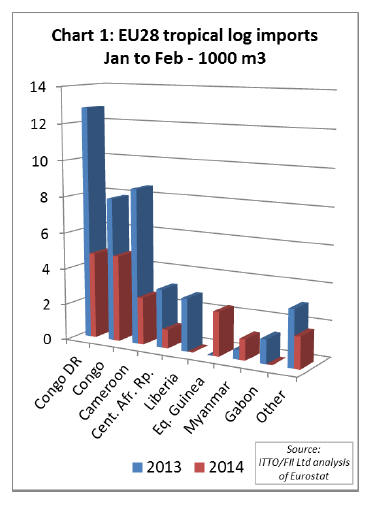
Longer term monthly data shows that after a brief spike in
early summer 2013, EU imports of tropical hardwood logs
resumed their long term decline between August 2013 and
February 2014 (Chart 2)
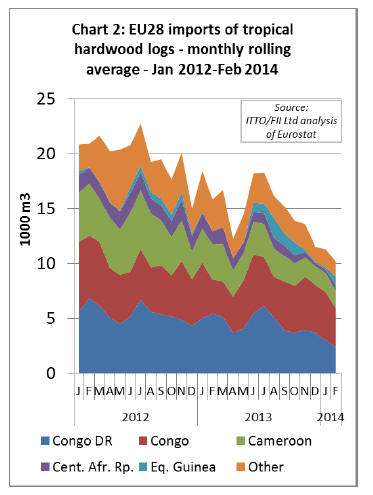
Amongst smaller suppliers, imports increased from
Myanmar in anticipation of the country‟s log export ban
imposed from April this year.
EU imports of logs from Equatorial Guinea only resumed
in the second half of last year and were therefore up
sharply in January to February 2014 compared to the same
period in 2013.
EU imports of sawn tropical hardwood fall sharply
EU imports of tropical sawn hardwood in the first two
months of 2014 were 147,326 m3, 8% down on the same
period in 2013. Imports fell from all three of the main
supply countries including Cameroon, Malaysia and
Brazil.
However, imports increased from some smaller suppliers,
including Gabon, Ivory Coast, and the Republic of Congo
(Chart 3).
EU imports of tropical sawn hardwood were low but stable
for most of 2013, but trended down sharply between
November 2013 and February 2014 (Chart 4).
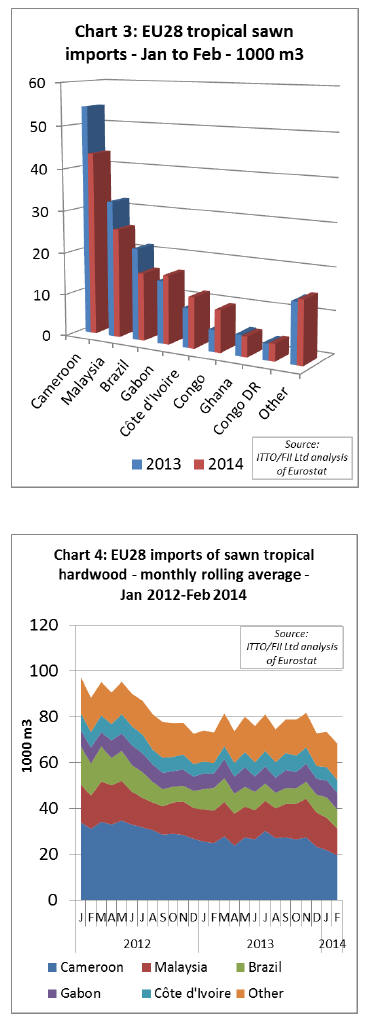
The low level of EU imports from Cameroon in early 2014
is partly due to short-term operational problems at the port
of Douala and volumes are likely to rise in the spring as
these problems are overcome.
However, European buyers are also struggling to obtain
sufficient volumes of preferred species such as sapele and
sipo as more is now being sold into the Asian and U.S.
markets.
EU imports from Brazil started the year 2014 very slowly,
mainly due to weak consumption during the winter months
in France and Belgium.
However, judging from Brazilian export data and
comments by EU importers, there has been more European
interest in Brazilian sawn hardwood during the spring
period, partly owing to on-going supply difficulties for
African sapele.
Demand for Brazilian sawn hardwood has been
particularly robust in the Netherlands this year, and has
also improved in France, Portugal and Spain in recent
weeks.
Weak EU imports of Malaysian sawn hardwood in the
opening months of 2013 follow stronger imports at the end
of 2013 when there was a rush to buy in advance of an
increase in European import duties.
EU imports of sawn hardwood from Malaysia and other
Asian countries have also been negatively affected by high
and volatile freight rates during 2014. Availability of
Malaysian sawn hardwood was also quite restricted in the
early months of 2014.
However the supply situation for Malaysian sawn
hardwood has now improved significantly so that standard
European dimensions can be shipped at short notice.
Better European consumption combined with improved
supply and availability of robust MTCC/PEFC
certification procedures, plus shortages of alternatives,
suggest better future prospects for Malaysian wood in the
EU market during 2014.
EU decking market starts slow but gaining momentum
EU imports of mouldings (including decking profiles)
were 25,860 m3 in the first two months of 2014, 20% less
than the same period in 2013. Imports fell from Indonesia
and Brazil, but were higher from Malaysia (Chart 5).
European imports of tropical hardwood decking were low
during the winter months when importers were concerned
about the persistence of unsold stocks from the previous
year on the EU market and uncertain about future demand
in 2014.
However, closer analysis of monthly trends indicates an
upward turn in EU trade in mouldings and decking during
February 2014 (Chart 6).
Imports are also likely to have increased again in March
and April with the relatively early arrival of good spring
weather in north-western Europe and rising consumer
confidence.
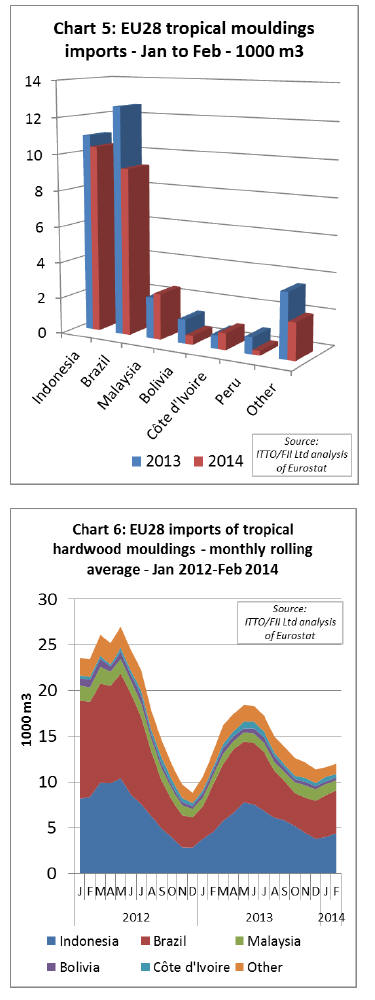
EU veneer imports show signs of revival
EU imports of tropical hardwood veneer in the opening
two months of 2014 were 45,746 m3, 19% more than the
same period in 2013.
Imports from Ivory Coast were over 60% higher in
January to February 2014 than they were during the same
period in 2013. Imports also increased from Gabon,
Cameroon and the Republic of Congo (Chart 7).
Analysis of the monthly data shows that EU imports of
tropical hardwood veneer have been strengthening
consistently since the end of 2012, with particularly strong
growth in imports from Gabon (Chart 8).
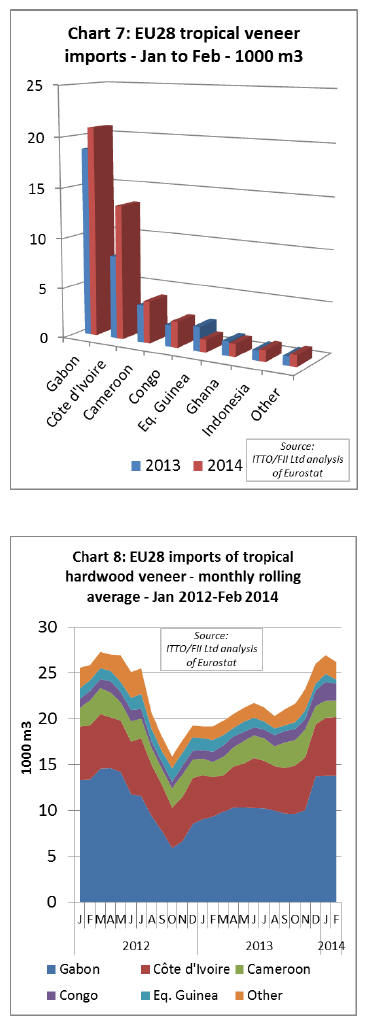
The upward veneer trade trend is partly a result of
Gabon‟s restrictions on log exports which has led to EU
manufacturers importing veneer instead.
Nevertheless, the recent rise imports from a wider a range
of African countries is an encouraging sign that the
European market is improving and buyers are being
encouraged to source higher value tropical products.
Downturn in EU imports of Malaysian plywood
EU imports of tropical hardwood plywood in the first 2
months of 2014 were 54,088 m3, 27% down on the same
period the previous year.
The opening months of 2014 were marked by a
particularly big downturn in imports from Malaysia and
Indonesia (Chart 9).
European trade with both countries has been severely
disrupted by volatile freight rates in 2014.
Slow EU trade in Malaysian plywood was also partly due
to a rise in EU import duties with the change in Malaysia‟s
GSP status on 1 January 2014. This is clear from monthly
data which shows a sharp spike in EU imports from
Malaysia in November 2013 followed by consistent
decline over the next 3 months (Chart 10).
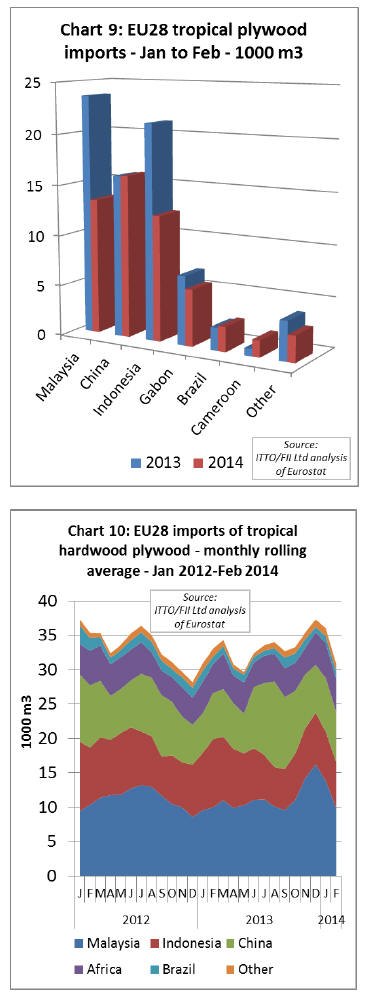
While EU imports of Indonesian plywood were weak to
end February 2014, demand has been rising since March.
European trade in Indonesian plywood has been boosted
by stronger construction sector activity, particularly in
Germany and the UK, and also by rising prices and
restricted availability of Russian birch plywood which has
been a significant competitor in recent years.
EU imports of tropical hardwood plywood from China in
the first two months of 2014 were at the same relatively
low level as in 2013. EU imports from China are now
much more heavily focused on Mixed Light Hardwood
(MLH) products comprising eucalyptus and poplar.
EU imports of MLH plywood in the first two months of
2014 were 143,196 m3, 13% less than the same period in
2013.
However EU imports of this commodity in the early
months of last year were inflated as importers built stocks
in advance of EUTR enforcement in March 2013.
Indications are that EU demand for Chinese MLH
plywood has been increasing in 2014 and is better than last
year.
Chinese MLH products bearing the Q-Mark issued by BM
TRADA are becoming particularly popular in Europe and
are taking market share from Malaysian tropical hardwood
plywood and Russian birch plywood.
The Q-Mark provides for CE-Marking of Chinese
plywood and gives an assurance that the product is fit for
purpose. Some Chinese manufacturers are now providing
products that are both Q-Marked and FSC or PEFC
certified for the European market.
|